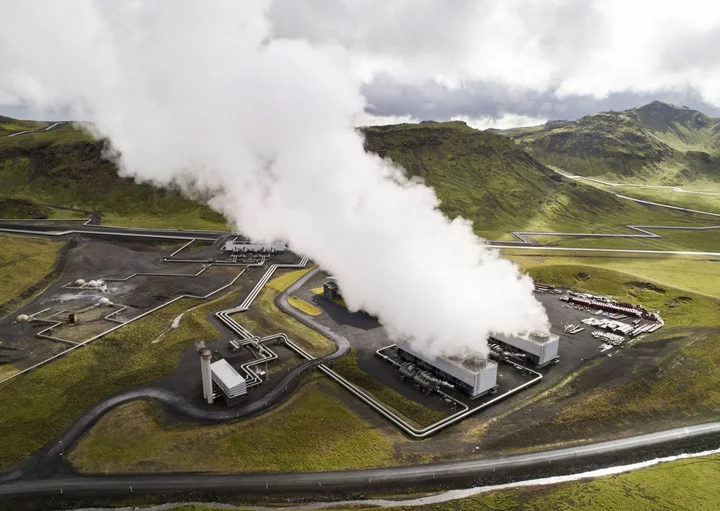Most everyone who’s committed their career to solving the climate crisis comes to the field because they have something they want to save. It’s the mountains for Christoph Gebald, whose startup, Climeworks AG, is among the pioneers of sucking carbon dioxide from thin air.
Gebald grew up in the Bavarian region of Germany, and he’s spent two decades in Switzerland, a country synonymous with jagged peaks cloaked in snow and ice stretching to the horizon. The shadow of climate change hovers over the Alps, though. The glaciers clinging to the slopes are receding at an alarming rate. Even the most optimistic scenarios show two-thirds of the Alps’ ice could disappear by the end of the century.
“I came here to study, and the original motivation was really being outdoors,” Gebald says. “I was all about mountain biking, climbing, ski touring and studies were, well, ‘Somehow I’ll get it done.’ ”
In between mountain ascents, he pursued research that’s now the basis for Climeworks’ mission: removing 1 billion tons of carbon pollution from the atmosphere every year by midcentury using, essentially, vacuum cleaners for the sky. That ambition is in part why Gebald was named to the TIME100 Next list last year.
Climeworks raised $650 million in an equity round last year and has sold millions of dollars in CO2 removal services. But those big numbers belie the massive challenge. If 1 billion tons is the summit, the company has barely taken its first steps out of base camp: It’s at 4,000 tons a year, and experts estimate that the world will need to remove up to 10 billion tons of carbon from the atmosphere annually by midcentury to limit global warming to 1.5C. In mountaineering terms, the route ahead is a Class 5 ascent: There’s exposure on both sides and little room for error. Plus, nobody has ever attempted it before.
Gebald is taking to heart the lessons he’s learned in the mountains. “If you only focus on the summit, you’ll be frustrated five weeks straight until you are on the summit,” he tells me on a warm Zurich afternoon as we sit cross-legged under a tree around the corner from his office. “What you focus on is the next step, and you only focus on the next step to not be killed.”
As chief executive officer and co-founder of Climeworks, the next step in front of Gebald is building a scaled-up version of its technology in Iceland; the step after that will be opening its first plant in the US. That project, which will anchor a test hub in southwest Louisiana for pulling CO2 from the air, was awarded hundreds of millions of dollars this summer as part of US President Joe Biden’s climate strategy. The Biden administration expects that hub to capture 1 million tons of carbon a year by 2030, with Climeworks doing most of the heavy lifting.
More and more corporations are purchasing or have announced plans to voluntarily buy hundreds of millions of dollars in removal services this decade as part of their decarbonization plans. BloombergNEF estimates that if the global carbon market were to rely on CO2 removal rather than reducing deforestation or funding clean energy projects—both common sources of carbon credits currently being sold—the industry could be worth up to $1 trillion by 2037. Focusing too intently on growing that market can’t come at the expense of cutting emissions, though. “What we don’t want these plants to do is to deter the rapid mitigation and the reductions that have to happen right now,” says Angela Anderson, the director of industrial innovation and carbon removal at the World Resources Institute (WRI).
Climeworks’ main competition is offering a very different vision. Warren Buffett-backed Occidental Petroleum Corp. has plans to build more than 100 carbon-sucking plants by 2035, and it wants to use some of that captured carbon to dredge up more oil, which is at odds with reducing emissions. That’s in contrast to Climeworks, which is only interested in “permanent underground storage, period,” Gebald says.
Oxy also won federal funding to construct a test plant. The two hubs will be fewer than 400 miles apart on the Gulf Coast, setting up a race between dueling techno fixes and visions where the very future of an industry that barely exists will be at stake. That is, assuming it can even scale in the first place.
Direct air capture (DAC) is among the technologies the world will likely need to avert the worst consequences of climate change. While wind turbines, electric vehicles and solar panels can reduce reliance on fossil fuels, some sectors of the economy—think flying, shipping or making cement—could remain stubbornly tied to carbon-polluting sources of energy. DAC holds the promise of hoovering up those emissions along with some of the CO2 put in the atmosphere over almost two centuries of industrialization. This effort to rebalance the climate employs large machines to snatch CO2 from the ambient air using a mix of physics and chemistry.
The eight machines Climeworks has deployed in Iceland look like guitar amps made for giants sitting next to the stark mountains. The plant’s 96 fans draw in air, and special chemicals called sorbents inside separate the CO2 before it’s sequestered in rock essentially for eternity using a technique developed by Icelandic startup Carbfix. The initial plant, dubbed Orca, is more proof of concept than climate savior, though. In a year, it turns enough CO2 into rock to remove less than 270 average Americans’ annual carbon footprints.
It’s the fruit of more than a decade’s work inspired by space shuttles and submarines. Circulation systems in both remove CO2 so their occupants have fresh air. Gebald was influenced by these systems while pursuing his Ph.D. at ETH Zurich. He wanted to see whether the techniques could be applied to clean the air with an eye toward a more habitable climate. He and Jan Wurzbacher, a fellow student and his co-founder, embarked on a path in 2008 to develop a way to pull carbon from the sky.
They landed on capturing CO2 on the cheap and selling it for use in everything from juicing plant growth in greenhouses to creating synthetic fuel.
The duo tried out sorbents in a testing chamber roughly a cubic inch, the size of a stack of a few AirPods cases. From that miniature scale, the company worked its way up to a trial on the roof of a waste incinerator in Hinwil, outside Zurich. Climeworks installed its system amid the aging trash sorting system. While the incinerator is caked in years of grime, the carbon collectors are all seamless construction and shiny metal. In 2017, the mini plant’s fans began pulling in air, passing it over sorbents and stashing the carbon in a balloon. The CO2 was then piped into greenhouses located nearby to spur plant growth.
That plan was in line with the best available science at the time, which focused on the need to reduce greenhouse gas emissions and then use captured CO2 for industrial purposes. This would create a closed loop for things such as aviation fuel, helping stabilize the atmosphere. But carbon emissions in 2022 were 1.4 billion tons higher than when the Hinwil plant started operations. And an evolving body of science has shown the need to not just stabilize the atmosphere but lower CO2 levels.
A chance encounter at the United Nations climate talks in 2016 between Gebald and Olafur Ragnar Grimsson, Iceland’s former president, set the wheels in motion for Climeworks to reimagine its plan. Grimsson was on a mission to use Iceland’s unique geology to stash carbon pulled from the atmosphere and its bountiful clean energy as a means to power the operations. Within months, Climeworks decided selling carbon for industrial use was out and permanently storing it underground was in.
Gebald found partners in Carbfix and the utility Reykjavik Energy. Together, they applied for and received European Union funding for a pilot project to use clean energy to power machines to grab carbon from the sky. The mission took on urgency in 2018, when a major UN climate report found that to limit global warming to 1.5C, the world will almost certainly need to remediate billions of tons of carbon every year in the coming decades. By 2020, Climeworks was at work building its Orca plant.
Climeworks’ Zurich facility is a whirlwind of activity every day. But in late June, it’s a full-blown tornado. The most pressing test is taking place in the courtyard. There, sandwiched between two buildings and towering 6 meters (20 feet) overhead, is one of the units Climeworks will install in Iceland soon, dubbed Manny. The roar of the fans drowns out anything less than a yell.
The company plans to install 24 of the collector units in the next year at what will be its Mammoth plant at Hellisheioi, the world’s largest geothermal power station, amid Iceland’s achingly beautiful, desolate landscape. When the fans begin whirring, Mammoth will set a mark as the biggest DAC plant in the world, capable of capturing an estimated 36,000 tons of CO2 annually.
Yet the plant will take a year to capture just 30 seconds of the world’s carbon pollution. Ambition versus reality is a central tension of DAC, one Climeworks and its main competitor, Oxy, have different ways of addressing. While Climeworks is moving step by step, gobbling up a few extra seconds of humanity’s emissions with each iteration of its technology, Oxy is trying to take a major leap. The oil company’s subsidiary 1PointFive is building a plant in Texas that it says will come online in mid-2025, removing as many as 500,000 tons of CO2 annually. It’s yet to prove its technology works anywhere close to scale, though.
The companies are also at opposite poles of what to do with the carbon. While Oxy won’t use carbon captured at its East Texas DAC hub for oil production, it does plan to do so at its West Texas plant. It then aims to sell the resulting crude as “net-zero oil,” a dubious phrase that’s at odds with the best available climate science. “If oil companies are investing in DAC so they can keep producing oil and keep drilling, that runs counter to what the IPCC is saying we have to do,” says Anderson of WRI. “We have to phase out fossil fuels.”
Gebald says Climeworks’ “vision is to remove CO2 from the air to address unavoidable or historic legacy emissions to achieve climate targets. Every molecule we have removed from the atmosphere was purely additional.” That said, he does see a role for oil companies, as long as they don’t use the CO2 to dig up more oil. One of the smaller DAC hubs Climeworks is working with includes California Resources Corp., a fossil fuel company, and Gebald says oil companies could help develop carbon storage given their vast expertise in geology. “Everything that is bringing speed to the table is a welcome guest,” he says.
Orders for Climeworks’ service are increasing. Bill Gates paid the company to remove CO2 from the air in an effort to address his high-carbon lifestyle, calling its work the “gold standard” in removals. Microsoft Corp., JPMorgan Chase & Co. and other companies have entered into agreements to pay Climeworks to remove thousands of tons of CO2, as have more than 19,000 individuals.
These early investments in Climeworks, as well as a number of deals with other DAC companies, are largely a symbolic line to include in sustainability reports for now—they aren’t meaningful contributions to decarbonization plans. And they’re just the tip of a multibillion-dollar infusion of cash the industry will need to scale beyond a line item for corporations and wealthy individuals. “Creating demand is a fundamental barrier to the industry,” Anderson says, underscoring that corporate commitments alone are not going to be enough.
Getting a toehold in the US, where most corporate buyers are based and government incentives are lining up, is vital for Climeworks. The hubs will be a big step. In addition to the major one in Louisiana, Climeworks is involved in two smaller test hubs in North Dakota and California. The varied geography will allow the company to test its machines in different conditions. It will also provide a clearer snapshot of what the industry will need to grow.
Since winning funding for the hubs, Climeworks has seen an uptick in interest from prospective buyers, Gebald says, as well as governments looking to build similar programs. “There’s going to need to be additional policies coming down the road,” Anderson says. She adds that those will likely include governments buying removal services, not just funding test facilities, in an effort to bring down costs.
The industry’s future hinges on that happening. Researchers have pegged $100 per ton of CO2 captured as the point at which the industry becomes stable. But so far, the numbers remain well above that. Individuals can pay Climeworks about $1,300 to remove a ton of carbon. Larger deals have come with a lower price per ton; JPMorgan paid Climeworks $20 million to remove 25,000 tons of CO2, which comes out to around $800 per ton.
Other DAC companies are in that range. There are 27 DAC plants commissioned globally and at least 130 more being proposed, according to the International Energy Agency. Although the coming years will likely bring lower costs and increased capacity, claims overselling DAC’s potential could undermine trust in the industry.
But money is pouring in. Venture capital firms are investing in startups building machines to remove CO2, as well as in companies with totally different techniques. Their approaches include adding special crushed rocks to fields that can speed up soil’s natural CO2-capturing processes and growing seaweed and then sinking it to the bottom of the ocean, effectively sequestering the carbon it captured while growing near the surface.
“Climeworks has invested so much in this thought leadership of where the field should go, I imagine they’ll likely continue to be a key player,” says Giana Amador, executive director at the Carbon Removal Alliance, an industry group of which Climeworks is a member. Gebald’s billion-ton aim, she says, “is probably ambitious for one company. But now is the time to be ambitious.”
Making a pioneering summit attempt wins bragging rights and a bigger piece of the $1 trillion market. If Climeworks lays out a path that shows carbon removal can be profitable without pulling more oil from the ground, it could help others do the same. And the more companies that achieve that, the better the chance of protecting the glaciers that inspired Gebald’s work in the first place.
“The field getting crowded is a good problem to have,” Amador says. “And we will honestly need it to get more and more crowded.”









